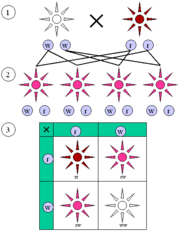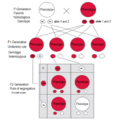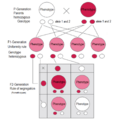Mendelian inheritance facts for kids
Mendelian inheritance is a set of rules about how living things pass on their traits from parents to their children. It's like a special instruction manual for how you get your eye color or hair type!
The main ideas behind genetics were first found by a monk named Gregor Mendel. He made his discoveries in the 1850s and shared them in 1866. For thousands of years, people had noticed that children often look like their parents. But Mendel's work was special because he did careful experiments with plants. He planned his experiments very well.
Mendel studied how traits were passed on in pea plants. He started with plants that always produced the same traits, like tall plants always having tall offspring. He looked at traits that were clearly one thing or another, such as either tall or short plants. He grew many plants and counted his results. He used special tests to find out about hidden (recessive) traits.
Contents
Mendel's Amazing Discoveries
Mendel's rules are very important and apply to most living things. They work for organisms that have two sets of chromosomes (like humans and most animals and plants) and that use sexual reproduction. These rules wouldn't apply to things like bacteria or organisms that reproduce without a partner. But they are true for the vast majority of plants and animals.
Mendel's Laws of Inheritance
Mendel explained what he found in his experiments with two main scientific laws:
- 1. The Law of Segregation:
Factors, which we now call genes, usually come in pairs inside the body cells of an organism. But when sex cells (like sperm or egg cells, called gametes) are made, these pairs separate. This happens during a process called meiosis. Each sex cell only gets one chromosome from each pair. These factors (genes) decide what traits an organism will have, and they are passed down from parents. Since the pairs of chromosomes separate, each sex cell only gets one of each factor. Mendel called this the Law of segregation.
- 2. The Law of Independent Assortment:
Alleles for different genes separate from each other independently when sex cells are formed. This means that the trait for plant height, for example, is passed on separately from the trait for flower color. Mendel called this the Law of independent assortment. So, he thought that different traits are inherited without affecting each other.
-
- This second law is only true if the genes are on different chromosomes. If they are on the same chromosome, they are often inherited together. This is called genetic linkage. Scientists later found that genes are carried on chromosomes. The closer genes are on a chromosome, the more likely they are to be inherited together. Sometimes, parts of chromosomes can swap places in a process called crossing over, which can mix up linked genes.
Mendel's laws explained the results he got with his pea plants. Later, scientists who study genetics found that his laws were also true for other living things, including humans. Mendel's work on pea plants helped create the whole field of genetics. His careful way of doing experiments and paying attention to numbers set a high standard for future scientific work.
How Traits Get Mixed Up
When chromosome pairs separate to form sex cells, they are mixed up randomly. This means a sex cell could get any mix of chromosomes from the mother and father. Also, during crossing over, sections of chromosomes can swap places. This creates new combinations of genes. Both of these things mean that, except for identical twins, no two siblings have exactly the same genetics. This mixing is super important for evolution because it creates variety in a population.
Seeing Mendel's Rules in Action
The pictures below show how traits are passed on. The numbers (like 3:1 or 1:2:1) are what we expect to see on average if we look at many, many offspring.

Figure 1: How dominant and recessive traits (called phenotypes) appear.
(1) The parent generation. (2) The first generation of offspring (F1). (3) The second generation of offspring (F2). The dominant trait (red) hides the recessive trait (white) in the F1 generation. In the F2 generation, you see a 3:1 ratio of dominant to recessive traits. |

Figure 3: The color alleles of Mirabilis jalapa (a type of flower) are not simply dominant or recessive.
(1) Parent generation. (2) F1 generation. (3) F2 generation. Here, the "red" and "white" alleles mix to make a "pink" trait. This leads to a 1:2:1 ratio of red:pink:white in the F2 generation. |
Images for kids
-
Myosotis: Colour and distribution of colours are inherited independently.
-
F1 generation: All individuals have the same genotype and same phenotype expressing the dominant trait (red). F2 generation: The phenotypes in the second generation show a 3 : 1 ratio. In the genotype 25 % are homozygous with the dominant trait, 50 % are heterozygous genetic carriers of the recessive trait, 25 % are homozygous with the recessive genetic trait and expressing the recessive character.
-
In Mirabilis jalapa and Antirrhinum majus are examples for intermediate inheritance. As seen in the F1-generation, heterozygous plants have "light pink" flowers—a mix of "red" and "white". The F2-generation shows a 1:2:1 ratio of red : light pink : white
-
When the parents are homozygous for two different genetic traits (llSS and LL sP sP), their children in the F1 generation are heterozygous at both loci and only show the dominant phenotypes (Ll S sP). P-Generation: Each parent possesses one dominant and one recessive trait purebred (homozygous). In this example, solid coat color is indicated by S (dominant), Piebald spotting by sP (recessive), while fur length is indicated by L (short, dominant) or l (long, recessive). All individuals are equal in genotype and phenotype. In the F2 generation all combinations of coat color and fur length occur: 9 are short haired with solid colour, 3 are short haired with spotting, 3 are long haired with solid colour and 1 is long haired with spotting. The traits are inherited independently, so that new combinations can occur. Average number ratio of phenotypes 9:3:3:1
See also
 In Spanish: Leyes de Mendel para niños
In Spanish: Leyes de Mendel para niños








